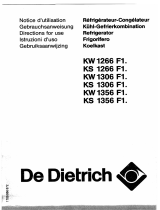Safety instructions and regulations
The cardboard box may be broken or cut
into smaller pieces and given to a waste
paper disposal service. The wrapping foil is
made of polyethylene and the polysterene
pads and stuffing contain no fluorochloric
hydrocarbons.
All these valuable materials may be taken to
a waste materials collecting center and used
again after adequate rework. (Recycling).
Consult your local authorities for the name
and address of the waste materials collecting
centers and waste paper disposal services
nearest to your home.
Regulations
The appliance may be used for the
refrigerating of food, freezing fresh products,
storing deep frozen goods and making ice. It
may be set-up in a room with an ambient
temperature ranging from +18ºC- +38ºC.
If the temperature of the room where the
appliance has been placed drops below +18ºC
the freezer switch should be connected. A red
mark will indicate it is on (figure d/22). On
connecting the switch, the inner light will
remain on at reduced power. This ensures that
the temperature required in the freezer
compartment for long-life storage of food is
maintained.
The appliance is intended for household use
only.
If using for commercial purposes, please
observe the regulations in force for the
particular trade branch.
It adheres to the current regulations for the
prevention of accidents caused by
refrigerating units (VBG 20).
The cold circuit was tested for leaks.
The appliance was built in compliance with the
current safety regulations for electrical
appliances.
All electrical repairs should be carried out by
qualified technicians.
Improper repairs, carried out by persons
lacking the necessary competence, could
represent a major source of danger for the
user of the appliance.
Safety instructions
This unit contains the coolant isobutane
(R 600a), a natural gas which is very
environmentally friendly but also
combustible. When transporting and
installing the unit care must be taken to
ensure that none of the refrigeration circuit
components become damaged. In the
event of damage avoid naked flames or
ignition sources and ventilate the room in
which the unit is placed for a few minutes.
How to dispose of the old unit
Before disposing of an old, scrap unit no
longer in use, it is imperative to render it
safe and inoperative at once. Disconnect
power supply plug and cut off connection
lead. Remove or destroy all spring, latch
or bolt-locks, ensuring that these have
been made totally unserviceable. This will
prevent the danger of children locking
themselves in inadvertently.
Please observe refrigeration and freezer
units contain insulating gases and coolants
which require specialised waste disposal.
They also contain valuable materials which
can be recycled. Entrust the disposal of a
scrap unit categorically to the competence
of your local waste disposal service and
contact your local authority or your dealer if
you have any questions. Please ensure that
the pipework of your refrigerating unit does
not get damaged prior to being picked-up
by the relevant waste disposal service, and
contribute to environmental awareness by
insisting on an appropriate, anti-pollution
method of disposal.
Disposing of the packaging of
your new appliance
All the packaging materials employed in the
packing of your new appliance may be
disposed of without any danger to the
environment.
Our contribution towards a cleaner
environment- we use recycled paper.
53
EN













